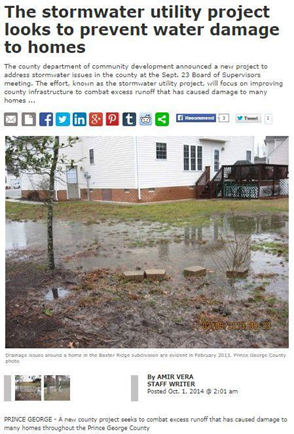Residents of communities that are close to bodies of water are often plagued by flooding and water buildup, especially when the region also experiences frequent, heavy rainfall.
The officials of one such place, Prince George County in Maryland, have recently taken stock of the situation in the county and formulated steps to address the effects of storm water runoff. Julie Walton, the Director of Community Development in the area, was quoted by The Progress Index staff writer, Amir Vera, as follows:
“Our county streams and waterways are heavily impacted by the increased flow off of our surfaces whether it’s rooftops, roads, driveways, pavements or parking lots. All of that contributes to additional water being carried away through our channels”
“with that, you have some pipe separations, sinkholes, failures of the concrete, slope failures in some of the channels,” Walton said. “The more we build the more runoff we produce, so as a locality as a whole as we expand we reduce more stormwater runoff.”
Prince George County officials are now looking into storm water utility projects that would put appropriate infrastructures in place to prevent flooding and excess water runoff.
However, while community leaders are tasked to come up with solutions to address problems such as these, residents and homeowners can also do their share. Effective storm water management practices may be adopted to help address the issue.
Installing permeable surfaces such as paving stones or bricks for patios and driveways would let the water seep into the ground. Planting trees and grass, as well as creating a rain garden in one’s backyard can also help in containing storm water. Choosing native plants for the lawn or garden is also a sound decision, as their roots are more suited for water retention.
Other technology-enhanced systems can also help. For example; installing downspouts that funnel rainwater from the roof to specialized water containers, such as a StormChamber system, is an excellent option. Such state-of-the-art storm water management BMP is easy to use, cost-efficient, and can also help in mitigating one’s contribution to water runoff within the neighborhood.
Once the chambers have been filled up, the collected water can be reused for such purposes as watering plants, irrigation, and washing cars. Residents can also have the water collected by professional sewage and drainage treatment specialists to make sure that when stormy weather arrives, their storm water containers are good to go.
Homeowners reap many rewards when adopting effective measures to respond to the challenge of managing storm water runoff. Not only will they be protecting their household and community from contaminated water supplies, they will also be cutting down on their water bills by reusing collected storm water.
(Source: The stormwater utility project looks to prevent water damage to homes, The Progress Index, October 1, 2014)






